
Announcement
Collapse
No announcement yet.
What Is The Axis Of Rotation In These Two Hitters?
Collapse
This topic is closed.
X
X
-
-
Great topic!
IMO initial axis of rotation is the back hip & when the mass becomes more centered it shifts to the front hip.
The location of the pitch & the type of hitter is most likey going to have an impact on the axis of rotation & the timing of the change from the back to front hip joint. For example, I would guess that a hitter like Jim Thome would be likely to use his back hip as the axis of rotation on balls down in situations where he is trying to drive the ball out of the park. A Juan Pierre type would have his front hip as his axis of rotation especially on balls up even through his initial rotation would start in his back hip socket.
I also think that that the timing of the shift in axis varies depending on pitch location, situation & the type of hitter.
Comment
-
IMO, the axis of rotation of ALL high level hitters (high level swings) on ALL pitches is the rear hip joint. The ball and socket joint.
As hitters coil and raise their lead foot to stride, they carry momentum forward. It's very individuallistic. Some do much more than others. I do not call this weight shift. I call that momentum creation. ALL of them, however, get a running start of the hips.....hip opening.....against a closed upper half.....and this momentum is rotational.....ie rotation into footplant......which is also involved in creating stretch between the two hemispheres. All of this rotation occurs around the rear hip joint. Pitchers do the same thing. From the point of coil reversal (coil turns into uncoil) the rotation is around the rear hip ball and socket joint with NO PAUSE.
Then.....at "go".....and not before.....in sync with the lateral tilt of the shoulders and the rotation of the forearms.....and blended into "one move".....the hitters push with their hips against the rear hip joint and against the upper body's "hold"....and push with their rear foot....which then shifts weight into the front side which blocks and gives rotation a "boost". The actual shift of weight from back to front does not happen until "go". Shifting it before "go" really bogs the swing down. I believe the "go" move actually puts the front foot down.
I do not believe there is EVER any rotation around the front hip joint. In hitting or in throwing. The rotation is "launched and spent".....as it is generated around the rear hip joint. The energy is then "caught" by the front leg which is used to brace/block/boost the already moving hips.....to keep any drift from occuring.
And I think the two greatest of all time exhibit what I've just explained.

Comment
-
Richard,
Interesting take.
As far as momentum creation vs. weight shift; IMO it's more a question of semantics since there is less weight on the back foot than before the stride initiation. However, I do feel that momentum creation is a really good term because it puts focus on the importance in building momentum early in the swing process.
No doubt that the back hip opening against a closed upper half with the shoulders resisting & the front foot blocking boost rotational force & prevent drifting.
Still there is rotation around the front hip. You routinely see it in the change of front foot angle before contact as the swing carries more weight into the front foot & the back hip gains momentum. With that being said, I looked at Bond's HR #720 & I can clearly see what you are saying relative to axis of rotation. Even though there is rotation in the front hip, the axis of rotation is in the rear hip.
http://www.buster.hittingillustrated.com/bonds-720.zip
JW
Comment
-
When I decide where the rotation comes from I think in terms of "engines".
What is producing the energy. Versus what is supporting, or enhancing, or offering a lever.
In the Second Engine hitting mechanics there are two engines. The Hands (forearm rotation to be more specific) and the Hips.
Each engine needs support for it to work efficiently. The Second Engine....the hands....must have the "resistance to rotation" from the shoulders for them to work efficiently. They need leverage....they need a platform from which to work against. The shoulders resistance provides that. If the shoulders are allowed to turn to soon, then the forearms lose their effectiveness. The leverage is gone. The engine for the Second Engine is the forearm rotation. The lever...or the support...is the resisting shoulders.
The First Engine....is the hip engine. And, IMO, it is the rear hip working in the ball and socket joint. That is where the energy is produced. The rear hip and leg loads in that joint, and the unloading from that joint is the first engine's energy source. So, the engine for the First Engine is the rear hip joint. It is offered leverage or support from the front leg as the weight is caught after the weight shift. Due to the running start of the lower body....the hips become angled away from their starting point (say a line parallel to a line from pitcher to catcher) such that a line through the hip bones at "go" is parallel to (roughly) the baseline on the hitters side. (Right handed hitters hips are parallel to the 3B line....or thereabouts...I'm not trying to establish degree....just a visual of how the hips open in relation to where they started) or....as I've said before....the hitters "private parts" can be seen by the pitcher at "go"....they are not hidden by the front leg. This hip angle is such that when the rear hip unloads (and this unload is very visible as the rear hip projects up and forward in the high level swing) and weight is shifted and caught by the front leg...that there is a leverage position offered by the front leg to give the rotation of the hips a boost. A lever to work against. To me this is not rotation around the front hip. The front hip is not creating energy...it is not a 3rd engine. There is no subsequent firing of yet another engine later in the swing. All engines are fired simultaneously at "go". The front leg is receiving the energy in such a fashion as to provide leverage to insure that rotation continues and no linear drift occurs.
I see a large difference between, and feel it is important to point out, the cause of rotation....versus the support of rotation. The cause is the rear hip. The support is the front leg.
Now....when you have these two engines working as defined above....in opposite directions.....hands turning the barrel rearward and the hips turning open.....when they "join" at "go".....you get the cusp....the sudden change in direction of the barrel.
Here is what I believe to be the selling point. (I tried to use your clip but it was going to take several conversions for me to get just one still frame....so I picked a similar clip of the same player from a similar view)

This position is Bonds "go" point. He has just set his lead foot down softly. And, while his front foot is down, virtually all of his weight is over his rear leg and he has maintained a load in the rear hip joint and rear leg. His hips are open, stretch is created.....he's ready.
From this point forward the front leg will block/brace and provide the lever used by the now angled hips, to insure rotation instead of drift as he unloads the rear hip and leg and as he shifts the weight.
I challenge you, or anyone, to get into this position....statically or dynamically....and create significant energy in the muscles that control the front hip joint. Because.....to me....if you're going to rotate around the front leg.....or any other joint.....there must be an engine in that joint. And, by significant energy, it must be at least as much as the rear hip joint has produced.
If you do.....you won't get off your backside. You will spin from the shown position.
I have never seen a hitter who appeared to have two engine firings at different points in the swing. Just one explosive move. One instantaneous launch and spend. It doesn't make sense to me for there to be another engine in the front leg.
Therefore.....I've concluded that "go" is from the "ride the back leg" position and it includes the following all blended into one synced move that creates the "immediate launch and spend" and the cusp.
1) Forearm rotation
2) Lateral tilt of the shoulders (resisting rotation)
3) Unload of rear hip and leg
4) Weight shift forward where it is caught by the firm front side lever.
Of course, all of these are unloading moves. In no way am I diminishing the loading process. We're just not talking about that now. Obviously coil is very important to this entire process.
Due to the time constraints.....I see no reasonable way to launch the First engine, the unload of the rear hip and the weight shift and then subsequently launch another engine in the front leg.
Yeager says the rear foot push is done before the front foot block. If you believe that, then there can be no simultaneous launching of the rear leg and the front leg. Therefore, no engine in the front leg. Therefore, no rotation about the front leg. It's just a helpful lever.
The Bonds/Ted clip shows that launch is not done with any toetouch/heeldrop move. Therefore, IMO, the front leg is not involved in the launch other than to provide the lever.


Comment
-
As to the semantics....I think it is a very important distinction to make between gaining momentum and weight shift.
Gaining momentum is just that. Hitters do that whether they swing or not.
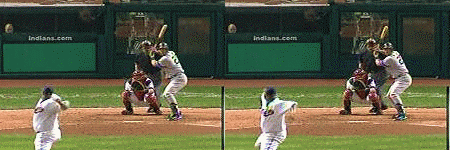
But.....there is something quite different between a check swing and a swing.
And that is the weight actually shifts to the front leg in a swing. The weight shift from back to front is involved in the "go" move. The load in the rear leg was maintained even though momentum was gained.
And the importance of the difference is simply that the rear hip is where the First Engine "go" comes from. It's a complete weight shift at "go". Not a partial shfit. It's a complete weight shift which is simultaneous to the other go moves listed above. AND.....how I learned this.....if you shift before "go" you are doomed. Simply gaining momentum implies that that is good in and of itself and more the merrier. However, shifting weight to the front foot before "go" is an absolute killer. If you do that, whatever your "go" move is is not supported by the powerful shift of the weight. You are out of sync. You shift then swing. You have a two part swing. You are not "one move". You have lost the energizing effect.....the airport people mover effect.....of the weight shift. You will not cusp. You will muscle the bat. You will constantly fight to catch up.
But, when these "go" moves are simultaneous and well synced.....you get the mechanical advantage that leads to the cusp. You move from "brute strength" hitting to "effortless power". You move from muscles to technique.
You move from Ron Gant to Lance Berkman.
Comment
-
A "somewhat good but must be loosely interpreted analogy" is....
The hitters do with their rear and front legs what a hockey player does with his as he skates.
There is a large push from the rear leg/hip and he catches himself with his front leg. The push of the rear leg is done before the catch of the front leg.
Now.....there will be a stride length difference, a body posture difference among other differences. But, add a hip rotational component to it and you have a similar analogy of the "feel" of the timing of the weight shift.
Comment
-
Rich,
Excellent, well-reasoned post. I agree with almost all of it, but not your main premise of the rear hip joint serving as the axis of rotation. You and I really discussed this back and forth a few months ago on private messaging. I have not been convinced of your arguement. Doesn't mean you are necessarily wrong, but I don't agree.
Even though anatomically, the spine is the true axis of rotation, I still see the front leg/front lever as not only supporting rotation, enhancing rotation as the front leg straightens in helping drive the front hip back, but also serving as an axis of sorts for momentum. That is momentum into, against, and around the front leg. Momentum that is transferred up the lever by way of the weight shift and hip rotation and further transferred to upper torso rotation. Besides the core muscles creating rotation, none of this momentum creation and transfer would be possible without the ground. Yeah, I can hang from a squat rack and rotate via core muscles, but it wouldn't amount to much in powering a swing, IMO....but I digress.
I believe and use the swinging gate cue, because nothing has yet persuaded me differently. Other than that, I agree with most of what you are saying, Rich.
Mike
Comment
-
Mike-
I think Richard's description is a good one. The problem is that the term "rotation" is really not a very good description of what hips do in an mlb swing where you are coiling the body by controlling the two ends/working the middle between them.
Rotation of the hips around the spine might make more sense for a middle out action, but that is not what we are talking about.
The coil/stretch early is more with rear hip joint/back leg as pivot than spine as axis, but in any case the hip motion is more complex than a pure rotation of the pelvis around a fixed axis. When the hips fire, the back hip is more of a thruster in a setting of resistance that powers the stretch and fire.
It is hard to describe the dynamic action involving this throw push from the back and the catch/push at the front. One thing to remember is that there is a large amount of coil/stretch/sit so that there is a lot of back hip thrusting as the front leg is catching. If you were thinking in terms of hip rotation or pelvic turn, you would certainly want to describe it as more of closing gate because otherwise you would just be encouraging spinning the hips as a revolving door.
But in general "turning" is not a great term given the associated weight shift/push catch of the legs.
The forward momentum that is created earlier is also important in later getting the axis/upper spine tilted forward/upright if necessary for high ball.
At the same time you are starting to sit to keep the muscles on stretch and be ready to continue to sit more for low ball when you do not have to get the axis more upright/forward.
Comment
-
Let's attack it from another angle.
Do you believe the forearms rotate and send the barrel rearward?
If not, we can't reconcile our differences.
If so, I believe I can convince you that the weight has to be back over the rear leg at "go". That doesn't mean you're not gaining momentum. But 100% of your weight is supported by the rear leg because the other foot is up in the air.
If your weight is 100% over your rear leg then there can be no other axis than the rear hip joint. It is the only moving part from the "ride the back leg" position.
To convince yourself, get into a "ride the back leg" position. Basically just stand up and lift your lead leg off the ground. Now, move your torso around. Turn it left. Turn it right. Where is the movement? The only place it can be is in the rear hip ball and socket joint.
That is the position hitters are in when their stride foot is off the ground. That is also the position hitters are in as the land their lead foot "softly" as seen in mlb video.
So....that leaves two options.
Option 1) The swing is swung from the rear hip joint before the front foot is weighted.
Or
Option 2) The swing is swung after the front foot is weighted with somewhere around a 50/50 distribution of weight front to back.
Option #1 is the only reasonable choice if you believe in handle torque and sending the barrel rearward at "go". Why?
Reason 1) Assuming you believe in the lower body running start....your hips will be angled at "go". Get out of you chair....angle your hips....weight both feet equally and swing. You immediately pull off the ball. You have little chance to cover the plate. You will stare at the outside corner pitch and you will flare or hit the inside pitch foul. The ball down the middle will saw off your bat.
Reason 2) Assume you don't believe in the lower body running start...so your hips are square at "go'. Get out of your chair....square your hips....weight both feet equally and swing. You can not swing in a diagonal swing plane and hit the ball. You have no path for the barrel to hit the ball. All you can do is the "mostly horizontal" swing plane and come around the ball. You can't stay inside.
Reason 3) Let's attempt Option 1. Get in your ride the back leg position....let the hip angle occur as a result of the running start....Now swing. Why can you now turn the barrel rearward and cover the plate? Because the weight is back....you can make a path for the barrel. You can energize the swing with not only the forearm rotation and lateral tilt but also with the explosive weight shift into the front leg lever.
Reason 4) You can not develop "one move" at "go" without the weight being back. If the weight is back, you have gained leverage for the weight shift, lateral tilt and forearm rotation to occur simultaneously. Not only simultaneously but "in sync"....and in the "same plane"....concentrically (I'm looking for the right words) with no part fighting the other....with no part working in the wrong plane or in the wrong direction....or grinding against the others. In other words....only with the weight back do the stars align for the body to work together as a unit to accomplish the task at hand with utmost efficiency.
And, as we learned above, if the weight is back....the only area of movement with the lead foot off the ground is the ball and socket of the rear hip. If that is the only joint for torso and lower body movement, and if you believe "go" is quick....one move....it makes no sense to conclude that another engine in the front leg is waiting to do it's work.


If you remember, this clip demonstrates the differences I talk about above. In the left clip Brandon couldn't hit the ball very well. In the right clip he was crushing the ball. It takes a keen eye to determine the differences in the swing. But....on the left, he's shifting his weigh to the front foot before he swings. He doesn't get open...he has no path. On the left, he rotates into footplant....keeps the weight back and has the large "boost" of the actual weight shift, as compared to momentum, ready to assist at "go". In both clips he has momentum. Only in the clip on the right is the weight shift proper.
Comment
-
I'm on a roll. I love to be challenged. And, I don't have to be right, contrary to popular belief. I just have to reach the truth.
And, I don't have to be right, contrary to popular belief. I just have to reach the truth.
It really makes my mind active.
Here is rotation around the front hip joint.

Here is rotation around the rear hip joint.
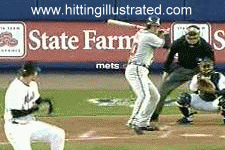
Pay attention to the rear hip. ILoveMe's rear hip comes around level and flat. The classic swinging gate. His engine is in the front hip joint.
Chippers rear hip projects upward and forward....as does all high levels swingers. The only way you can do that is with an engine in the rear hip joint working against a front leg lever.
Try it.
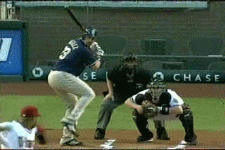
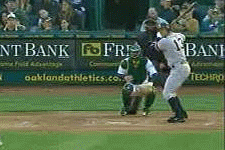


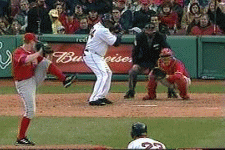
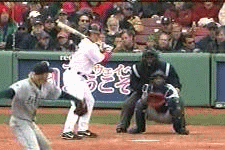
Comment
-
Tom,
What then is the main engine? In my mind it is the core muscles that power the hip turn in combination with some push from the back foot, and from stretching taking place during hip cock. If we're talking about upper torso rotation, then x-factor stretch would have a huge influence on rotation.
You do load into the rear side during the beginning of the stride as the front foot is lifted and the front hip is cocked. But are you not also loading the core muscles, as well? I think so. As rotation begins into toe touch or even flat foot landing of the front foot, the core unloads as hips lead the way. You may unload off of the back leg and back hip, but I view that as more of a "thruster" action as you described. I see no axis (we're not counting the spine in this scenario) other than the front leg.
When I see the Bonds and Williams clips, I see swinging gate rotation. The way I see it, without the posting of the front leg, the hitter is powerless. Another way of looking at it would be to actually use the back leg/hip as an axis and swing a bat while keeping the front leg off the ground.
I'm searching here and trying to understand.
Mike
Comment
-
Richard, I love to challenge you and I appreciate your willingness to engage in discussion. But, alas, this will have to wait until tomorrow. Don't lose your thought process because I will be back! What's great about this site is the discussion of ideas, which is missing from many other sites.
Mike
Comment

Comment